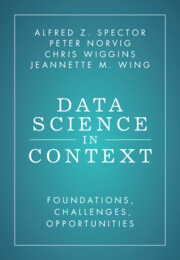Refine search
Actions for selected content:
1835 results in Knowledge Management, Databases and Data Mining
Recap of Part I: Data Science
- from Part I - Data Science
-
- Book:
- Data Science in Context
- Published online:
- 29 September 2022
- Print publication:
- 20 October 2022, pp 41-44
-
- Chapter
- Export citation
Tables
-
- Book:
- Data Science in Context
- Published online:
- 29 September 2022
- Print publication:
- 20 October 2022, pp xi-xii
-
- Chapter
- Export citation
Appendix - Summary of Recommendations from Part IV
-
- Book:
- Data Science in Context
- Published online:
- 29 September 2022
- Print publication:
- 20 October 2022, pp 278-279
-
- Chapter
- Export citation
Part III - Challenges in Applying Data Science
-
- Book:
- Data Science in Context
- Published online:
- 29 September 2022
- Print publication:
- 20 October 2022, pp 109-228
-
- Chapter
- Export citation

Data Science in Context
- Foundations, Challenges, Opportunities
-
- Published online:
- 29 September 2022
- Print publication:
- 20 October 2022

The Flexibility Paradox
- Why Flexible Working Leads to (Self-)Exploitation
-
- Published by:
- Bristol University Press
- Published online:
- 15 September 2022
- Print publication:
- 04 March 2022

Data Analytics for Cybersecurity
-
- Published online:
- 10 August 2022
- Print publication:
- 21 July 2022
3 - Introduction to Data Mining
-
- Book:
- Data Analytics for Cybersecurity
- Published online:
- 10 August 2022
- Print publication:
- 21 July 2022, pp 29-59
-
- Chapter
- Export citation
11 - Future Directions in Data Analytics for Cybersecurity
-
- Book:
- Data Analytics for Cybersecurity
- Published online:
- 10 August 2022
- Print publication:
- 21 July 2022, pp 147-164
-
- Chapter
- Export citation
6 - Anomaly Detection for Cybersecurity
-
- Book:
- Data Analytics for Cybersecurity
- Published online:
- 10 August 2022
- Print publication:
- 21 July 2022, pp 91-100
-
- Chapter
- Export citation
Index
-
- Book:
- Data Analytics for Cybersecurity
- Published online:
- 10 August 2022
- Print publication:
- 21 July 2022, pp 189-192
-
- Chapter
- Export citation
5 - Types of Cyberattacks
-
- Book:
- Data Analytics for Cybersecurity
- Published online:
- 10 August 2022
- Print publication:
- 21 July 2022, pp 78-90
-
- Chapter
- Export citation
References
-
- Book:
- Data Analytics for Cybersecurity
- Published online:
- 10 August 2022
- Print publication:
- 21 July 2022, pp 165-188
-
- Chapter
- Export citation
10 - Human-Centered Data Analytics for Cybersecurity
-
- Book:
- Data Analytics for Cybersecurity
- Published online:
- 10 August 2022
- Print publication:
- 21 July 2022, pp 137-146
-
- Chapter
- Export citation
2 - Understanding Sources of Cybersecurity Data
-
- Book:
- Data Analytics for Cybersecurity
- Published online:
- 10 August 2022
- Print publication:
- 21 July 2022, pp 14-28
-
- Chapter
- Export citation
Acknowledgments
-
- Book:
- Data Analytics for Cybersecurity
- Published online:
- 10 August 2022
- Print publication:
- 21 July 2022, pp xii-xiv
-
- Chapter
- Export citation
Copyright page
-
- Book:
- Data Analytics for Cybersecurity
- Published online:
- 10 August 2022
- Print publication:
- 21 July 2022, pp iv-iv
-
- Chapter
- Export citation
7 - Anomaly Detection Methods
-
- Book:
- Data Analytics for Cybersecurity
- Published online:
- 10 August 2022
- Print publication:
- 21 July 2022, pp 101-111
-
- Chapter
- Export citation
8 - Cybersecurity through Time Series and Spatial Data
-
- Book:
- Data Analytics for Cybersecurity
- Published online:
- 10 August 2022
- Print publication:
- 21 July 2022, pp 112-127
-
- Chapter
- Export citation
9 - Cybersecurity through Network and Graph Data
-
- Book:
- Data Analytics for Cybersecurity
- Published online:
- 10 August 2022
- Print publication:
- 21 July 2022, pp 128-136
-
- Chapter
- Export citation
